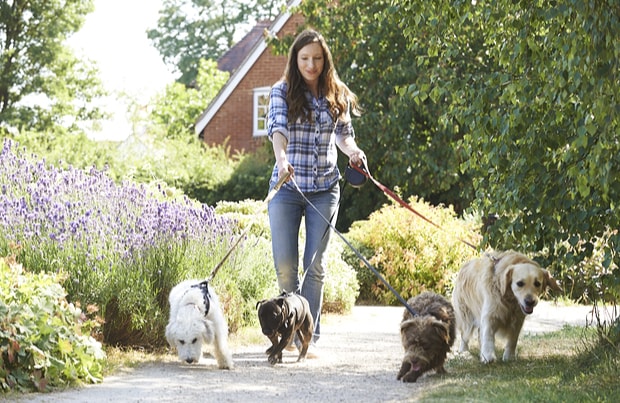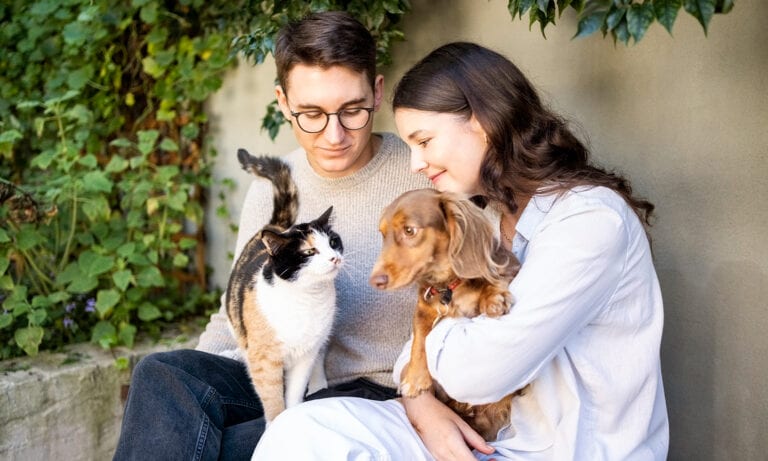Walking more than one dog at the same time requires equal parts negotiation, puppeteering, and finesse. The frustrations that can come with single-dog walks—like getting dragged down the street and dealing with leash manipulation while picking up poo—can multiply with each dog you add. With practice it is possible to have pleasant multi-dog strolls, and the following tips will help bring peace to your canine caravan.
Start With Solo Training
It’s necessary to teach each of your dogs proper leash walking manners before you attempt to set out as a threesome or moresome. Even though it multiplies your workload during the teaching phase, walking dogs individually enables them to learn the basics of good dog leash behaviors in a focused manner. Plus, solo walks are always a good idea, as every dog likes to be the center of attention now and then. So what are the most important aspects of polite leash walking? Pulling is never allowed, hanging out near you is always a good idea, and picking a side and sticking to it is appreciated.
Stopping your dog from pulling on the leash is one of the most important behaviors to master before heading out with multiple canines. Any time your dog forges ahead and the leash goes tight, stop in your tracks. When your dog slackens the leash by taking a few steps back to you, continue walking. Keep in mind that you’ll have to repeat this sequence frequently until your dog understands that a tight leash makes the walk stop.
Keeping your dog close is another important step to master. Whenever your dog is near you, mark the position either with a clicker or a special word like “good,” and then give your dog a soft, tasty treat. With enough repetitions your dog will soon choose to walk close to you because that’s where the deliciousness happens.
Finally, ensuring that your dog sticks to one side will help keep everyone comfortable. You don’t want your walks to be strict military exercises, where your dogs walk in a tight heel next to you, but you do have to maintain a sense of order when walking multiples. Encouraging your dogs to walk on either the left side or right side of your body rather than zigzagging in front of you will prevent puppy pile-ups and crossed leashes. You can encourage this “side preference” by always giving your dog a treat on the same side of your body, meaning, every time you want to reward your dogs make them come to the same spot close to the left or right side of your body. You can also discourage zigzagging by body blocking your dog if he attempts to step in front of you. If you notice your dog starting to cross in front of you simply “steal” the space away from him by walking where he intends to walk.
Equipment Matters
The leashes you select can impact the quality of your walks. They should be roughly the same length (5 – 6 feet, with no more than a foot difference in length between them), with handles that can fit comfortably in your hand. You might opt to hold both leashes in one hand, so select a material that isn’t bulky or difficult to loosely wrap around your hand (keeping in mind that wrapping the leashes too tightly can cause injury if you dogs decide to take off after a squirrel). While some leashes feature comfortable padded handles, holding two in one hand can be challenging.
Pet parents who want to keep both hands free while walking multiple dogs can benefit from a leash system that attaches to the waist. This is particularly helpful for pet parents with back and shoulder issues, as any potential leash tension is distributed through the center of the body instead of being concentrated in pain points.
It’s tempting to use flexible-length leashes when walking multiple dogs since they seem to allow more freedom, but navigating these leashes can be challenging at best and dangerous at worst. It’s tougher to engage the lock button when juggling multiple dogs, and it can be difficult keeping the cords from tangling without a great deal of handle navigation.
A coupler—which is a strap of nylon or leather that runs between two dogs and attaches to a single leash, might seem like a great way to keep dual walks manageable. However, it can actually cause friction between dogs if they aren’t perfectly matched in temperament, size, and walk-style. If you have one dog that likes to sniff and one that likes to wander, or a dog that outweighs the other, or a dog that likes privacy when he potties, the coupler’s forced closeness is bound to make the walk unpleasant for at least one of the dogs
Multi-Dog Leash Walking: Same Side or Different Sides?
All parties should be happy and comfortable during multi-dog walks, so deciding where your dogs should orient themselves in relation to you—on the left side or right side of your body—is a matter of personal preference. With well-mannered dogs that don’t pull, it’s possible to comfortably hold both leashes in the same hand, which encourages your dogs to walk closer together. This also allows you to keep one hand free for occasional treat delivery. Keep in mind that holding the leashes in separate hands might lead to zig-zagging in front of you as your dogs attempt to check in and keep up with each other.
Dealing with Leash Tangles
No matter how well mannered your dogs are, you should expect occasional twisted leashes. Teaching your dogs a casual “wait” cue will get them to stop moving while you make the necessary adjustments. To teach it on the go, simply come to a stop and tell your dog “wait.” Capture the moment your dog stops moving with a click or marker word (you’re basically acknowledging the absence of movement), then continue walking. Perfect it with each dog individually and then give it a shot when you have to unknot the mess.
Clean-Up Time Tips
Multiple dogs means multiple waste deposits, and dealing with pick-up can be challenging when juggling more than one pup. The easiest way to get the job done is to wrap the leashes around your foot and rest your full weight on them while you do the dirty work, which leaves both hands free for the necessary bag manipulation. However, this technique is only safe for dogs that aren’t prone to take off unexpectedly.

Victoria Schade is a dog trainer, author & speaker who has contributed to The Washington Post, Martha Stewart, and other publications.
Share:









